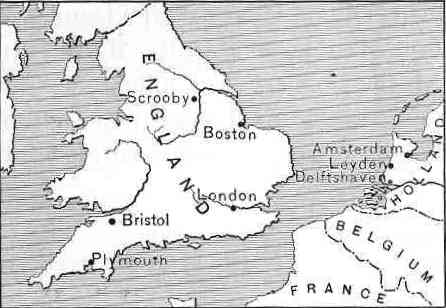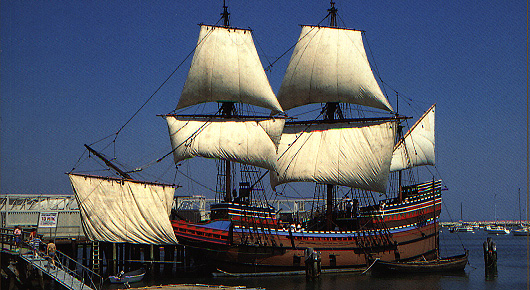
Online Texts for Craig White's Literature Courses
|
Of Plymouth Plantation by William Bradford
Instructor's Overview of Chapters I-IV |
|
Instructor's Notes:
-
William Bradford (1590-1657) was governor of the Pilgrims' colony at Plymouth. He had been a member of the church community that formed the Pilgrims from its earliest days and his childhood in England and during their sojourn in the Netherlands., Of Plymouth Plantation is a journal or memorial he kept during his lifetime in Plymouth.
-
Pilgrims and Puritans, as a highly literate early modern society, were devoted to keeping journals about their lives, feelings, and events in the world around them, creating an unsurpassed set of records among early European Americans. This is one reason why the Pilgrims and Puritans have such an enormous influence on American history despite being a numerical minority.
-
The early chapters of Plymouth Plantaion are difficult but priceless—
-
Difficult because Bradford's English diction and style are 400 years old, and also because religious history is hard to keep up with or care about. (Most Americans, no matter how religious, despise learning the history of religion, as though any sense of religion's "history" corrupts its supposedly timeless appeal, and besides suggests that religion, like all existence, evolves.
-
Priceless because an actual participant describes the religious and cultural background for the first permanent settlement of English-speaking colonists and the rise of America's dominant culture.
-
-
One particular difficulty with Bradford's text and its historical background is the many names for his group, among them Pilgrims, Puritans, Separatists, Non-Conformists, Radical Protestants, Dissenters, etc. (In Immigrant Literature, the Puritan & Pilgrim names are used more or less interchangeably—there were historical differences between the two groups, but after 400 years they aren't different enough to make a big deal of in a course like this.
Chapters 1-4 overview:
Chapter 1 is the most difficult prose this course reads, largely because it's written in Shakespearean English about a subject few Americans care about: church history.
But this context is essential for understanding the story that follows and the model it creates for the Pilgrims as an immigrant community and a prototype of the USA's dominant culture.
That context is the Protestant Reformation against the Catholic Church and its influences in the 1500s and 1600s, as experienced by a small community of English families who traveled from the English Midlands to the Netherlands to North America (New England).
Setting: "North parts" refers to Germany, England, and other areas of Northern Europe where the Protestant Reformation was centered
The Pilgrims were radical Protestants seeking to establish a separate religious order from the "Church of England," which they associated with the Catholic Church or "popery." (The Church of England is Protestant but retains many Catholic influences—for example, the Church of England's nearest American relation is the Episcopal Church, which can resemble a Catholic Church for Protestants: plenty of liturgy or ceremony, sensory appeals like colors and scents in contrast to the plain style of most Protestantism.)
In contrast to the ceremony and splendor of Catholic church styles, the Puritans wish to return to an "ancient purity" and "primitive order" based on the simpler church community of the Apostles in the generation following Jesus's life on earth. (Such impulses remain a motive of modern Evangelical Protestantism.)
The Church of England represents the bad old ways against which Bradford and other Protestants rebel, and for which they are "hunted and persecuted on every side," forcing them to leave their homes
end of chapter 1: English communities resolve to go into "the Low Countries" = the Netherlands or Holland. Map below shows the short distance from England to Holland.

Chapters 2-4: concerns how the Pilgrims, persecuted in England, first moved to Holland ("the Low Countries" or The Netherlands).
The Pilgrim community first journeys from the English Midlands to the Netherlands or "Low Countries." In this stage of their journey, the Pilgrims resemble later immigrants to America. They work hard and appreciate religious freedom,
BUT . . .
Their children start assimilating to the freer Dutch ways. The adult Pilgrims don't like this. In Holland, they basically refuse the typical immigrant pattern.
Some then decide to move to "some of those vast and unpeopled countries of America, . . . where there are only savage and brutish men . . . little otherwise than the wild beasts . . . ."
In brief, the Pilgrims wish to assimilate neither to the Dutch nor to the "savage and Brutish" Indian culture then in America.
In this regard the Pilgrims differ from later immigrant groups, who come to America with the idea of "joining up" with the existing system of government and economics (more or less).
The Pilgrims more resemble the Jews in Exodus and their attitude toward the "Promised Land" of Canaan, where they are told not to intermarry or take up Canaanite ways.
In other words, instead of assimilating to the existing culture in the New World (that of the American Indians), the Pilgrims do not assimilate but remain separate.
Thus the Pilgrims become a prototype of the USA's dominant culture: they do not assimilate but are assimilated to. (A few exceptions then and now.)
More on Protestant Reformation
Pilgrims and Puritans as part of "Protestant Reformation" in which Protestant churches and denominations separated from Catholic church that dominated Europe in earlier centuries
1517: Martin Luther publishes 95 Theses protesting errors of Catholic Church (Quincentenary or quencentennial in 2017)
Protestant Reformation peaks in 1600s, "the Seventeenth Century"--marked by wars of religion
1700s: Enlightenment or Age of Reason cools down religious attitudes, establishes secular governments like ours, but . . .
But the Protestant Reformation never really ends . . . always new churches and denominations springing up in protest of errors of older churches + attempt to return to earlier, simpler, stripped-down style of the early church.
For example, The Great Awakening of the early 1700s, followed by the Second Great Awakening of the early 1800s (and maybe a third at turn of 20th century, plus more?)
Today old-denomination churches like Presbyterians, Lutherans, even Methodists are struggling to survive as their members age and young people shift to
evangelical churches like Church of Christ, Assembly of God, Baptist Church, Missouri Synod Lutheran
or "non-denominational" churches like the Vineyard, the House Church, the Emerging Church movement & non-denominational mega-churches like Lakewood or Grace.
(or increasingly in the New Millennium, "no religious affiliation")
Eventually these new movements will become older denominations and cool off, upon which another phase of Protestant Reformation will pick up
Reasons for this information:
Pilgrims as part of Protestant Reformation
American dominant culture established as Protestant, remains almost exclusively Protestant until arrival of Irish Catholics in 1840s-50s.
Protestantism compatible with other aspects of American character: individualism, literacy, capitalism, nuclear family values, plain style.
Protestant Reformation moves toward modern world of change and expansion.
Evangelical Protestantism: world moves forward to future but heart reaches back to past
Whatever an immigrant's religion, they're assimilating to a culture based partly on Protestantism as a "base culture."
Protestantism compatible with dominant culture: emphasizes personal literacy, reading Bible for oneself (questionable how much this is done, but ideal and motive for reading)

replica of The Mayflower

